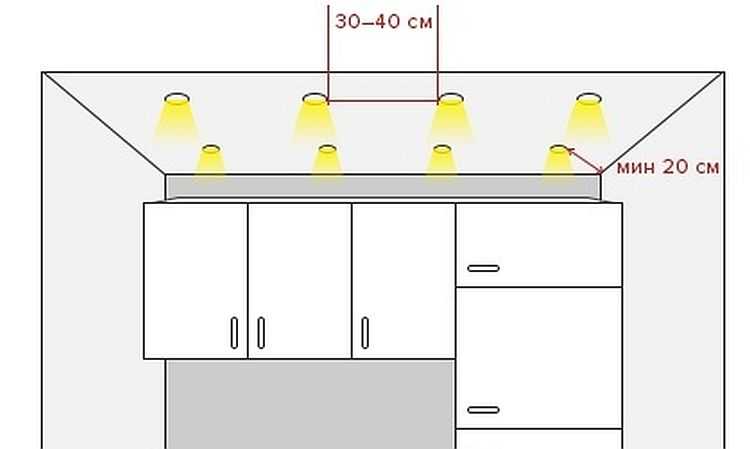How to arrange the lighting fixtures on a suspended ceiling
Proper placement of lighting fixtures on the suspended ceiling will not only make the room cozy, but also create a comfortable environment for rest and work. Thanks to a well chosen scheme, you can provide good lighting of the necessary areas or highlight individual elements of the interior. To choose the best solution, you need to take into account a few recommendations.
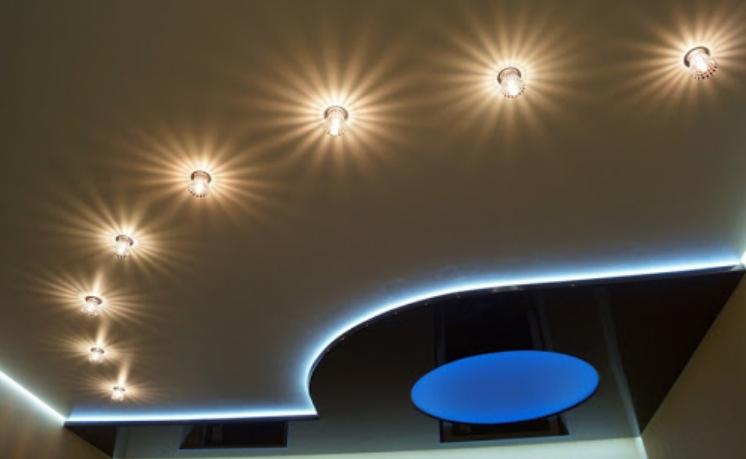
Recommendations for the placement of lighting fixtures
There is no regulation that regulates the rules for the placement of spotlights in the stretch ceiling. On the one hand, it does not limit your preferences, on the other hand - you can make a number of mistakes and the result will not be the best. General advice - take into account the purpose of the room. If it is a place of rest, it is better to use dim light, if it is a working area - you need high-quality lighting, close to natural light.
Placement rules
If you take into account the simple recommendations, it is not difficult to choose the right lighting. The main thing is not to rush and well think through every detail, so as not to miss any important aspects. Remember the following:
- When placing fixtures symmetrically, it is worth carefully checking their location, so that there is no displacement. If the equipment stands crooked, the appearance of the ceiling and illumination will be compromised.Observe the minimum distance.
- It is better to put a separate switch for each zone. If there are many spot elements, it is better to think about how to divide them, so as to turn on only the part that is needed at a certain moment. This will not only reduce electricity consumption, but also allow you to illuminate only one zone.
- If a transformer is included, place it so that it is easily accessible. Most often it is this element that burns down, so it is worth thinking in advance about where to install it, so that if necessary, without any problems to replace it.
- Choose housing size to the peculiarities of the ceiling. It is necessary to know exactly the distance from the cloth to the ceiling to choose a suitable model and it is not resting on the ceiling. The minimum distance should be 5 cm.
- You can arrange the equipment in lines, semicircles, snakes, etc. There are no restrictions, but it is necessary to choose a variant in advance and apply marks to make sure that the result will look attractive.
- Make bright lighting for the work area, for the rest area a dimmed one. Take into account the presence of other light sources (chandeliers, sconces), as they also give an effect.
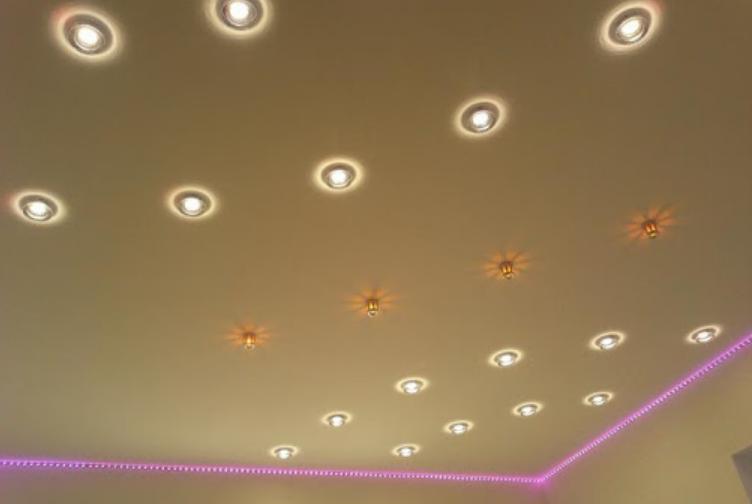
Tip! If you need to shift the accents of lighting or adjust the direction of light, it is better to put swiveling lights.
Take into account and standards for lighting for different rooms. They are set in accordance with sanitary regulations on the basis of a square meter of area. In the list of the first indicator - for incandescent lamps, the second is for fluorescent options, the third is for LEDs:
- For the hallway, 10, 6 and 2.5 watts.
- For the bathroom, 20-22, 14 and 5.2 to 5.4.
- For the nursery, 60, 36, 6.8.
- For the kitchen, 26, 15 to 16 and 6.8.
- For the bedroom, 12 to 15, 8 to 10, 2.7 to 3.4.
- Hall or living room - 20 to 22, 13 to 14, 5.2 to 5.4.
If you are guided by the norms, it is not difficult to determine the number of fixtures by adding up their total power and dividing by the area of the room.
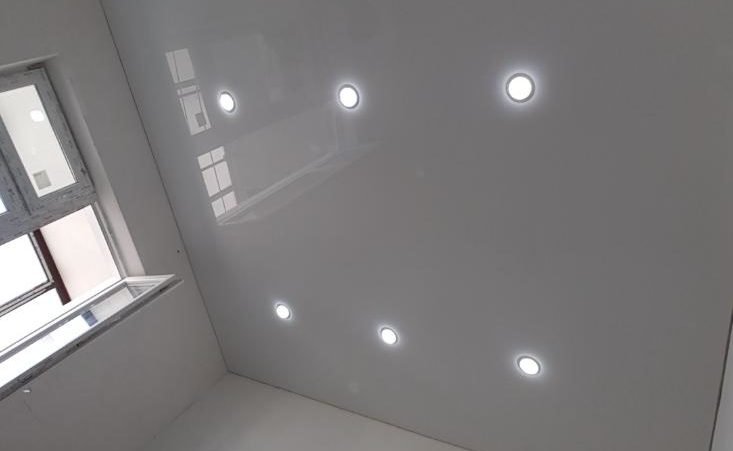
Recommendations for selecting light fixtures
Given a few simple tips to choose a light fixture is not difficult. If you know the placement of points and the arrangement of furniture in the room, there will be no problems with the calculation of power. But there are a number of other criteria that should not be forgotten:
- The degree of moisture resistance.. For the bathroom, bathroom or kitchen, it is better to choose models with increased protection against moisture, which are marked IP44.
- The type of bulb used. It is better not to buy variants with traditional incandescent bulbs, because they are very hot, which is undesirable for a suspended ceiling. Fluorescent and halogen are also not the best option. The ideal solution - LEDs, they consume little energy and do not heat up much when working.
- Appearance. Spotlight should be combined with the light of the ceiling and fit into the interior.
- If you need to shift the emphasis of lighting, it is better to choose rotary options.
Tip! Do not buy the cheapest models, their quality usually leaves much to be desired, and the service life is short.
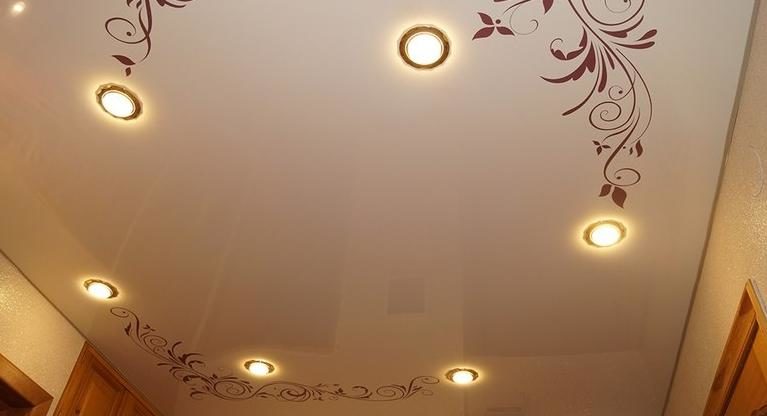
When choosing spotlights Take into account the type of socket and the ease of lamp replacementThe easier it is to do - the better. Variants with LEDs can be without lamps, in which case, if they fail, you will have to buy new ones or take apart and re-solder the diodes, which is not very easy.
Spacing of fixtures, basic rules
To make the room illuminated well, and the ceiling looked nice, you need to follow a few rules for the location of lighting fixtures. Here it's simple:
- From the wall to the edge of the spotlight should be at least 20 cm. If you place it closer, then the most part of the light will go to the wall, which can be useful only if you want to illuminate a painting, a sculpture or something else. It is better to step back from the wall at 25-30 cm, but in small rooms use the minimum rate.
- The distance between spotlights should not be less than 30 cm. This is the minimum allowable value, which should be measured from the edge of the enclosure, not from the center. But it is better to put the equipment in 40-50 cm, so you can provide good light and at the same time the ceiling will look neat. But to place spotlights at a distance of more than one meter is not worth it.
- If there are seams on the stretch ceiling fabric, do not place the equipment closer than 20 cm from them. This decreases the reliability of the fabric and the risk of tearing increases several times. If possible to step back from the seams at 25-30 cm, to plan the position of the lights so that near the junction was not empty space.
If on the package or in the instructions for the lamp there are standards for its installation with distances greater than those specified, you need to comply with them. To roughly determine the location, it is worth making a simple diagram with a plan of all the lights in the room.
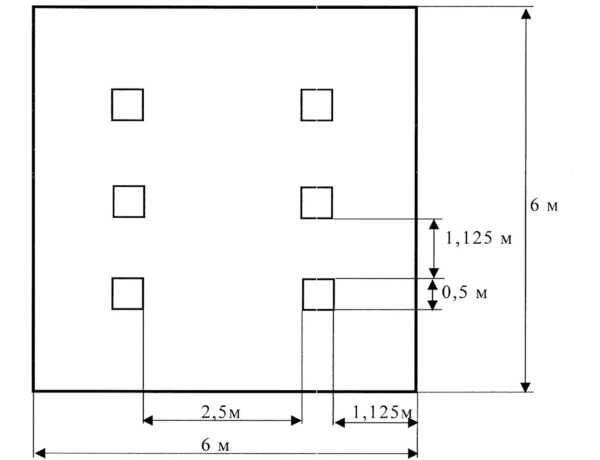
Popular layouts for different rooms
The location of spotlights depends on the room in which they are installed, its area and the nature of its use. Each room has its own rules to follow. Shown below are several placement options both without and with a chandelier.

Entrance hall and corridor
Most often the room has an elongated shape, a small width, and no natural light in it. Hallways and entrance halls in private homes are an exception. Here it is important to remember the following:
- With a width of more than one and a half meters, it is best to put spotlights on the perimeter. This is enough to illuminate the room normally. In narrow corridors, it is worth placing equipment in a single row in the middle.
- To add light and volume, it is better to use light glossy ceilings and built-in fixtures of small size.
- You can hang mirrors on the walls and place sconces near them to add light.
- Highlight the area near the mirror, if there is one.
In this case, adjustable options will work well. After installation, you can set the light so that the room is illuminated evenly over the entire area.
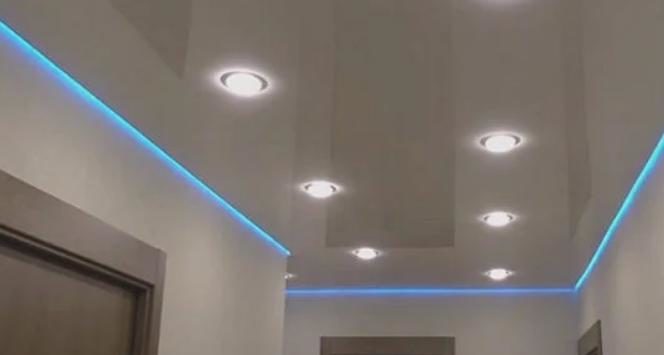
Kitchen
Here it all depends on the size and shape of the room. The larger the area, the wider the possibilities for design. However, there are general recommendations that should be kept in mind:
- For a small kitchen, you can make spotlights the main source of light. In this case, they should be placed in a staggered order across the surface.
- In rooms of medium and large size are usually combined built-in options and a chandelier in the middle.
- Very well, spot lighting will be suitable for highlighting the dining area. There you can place several lights and let them have a separate switch button.
- The work area should be illuminated in this way only if there are no hinged cabinets in the kitchen.
- It is better to use models with increased protection against moisture.
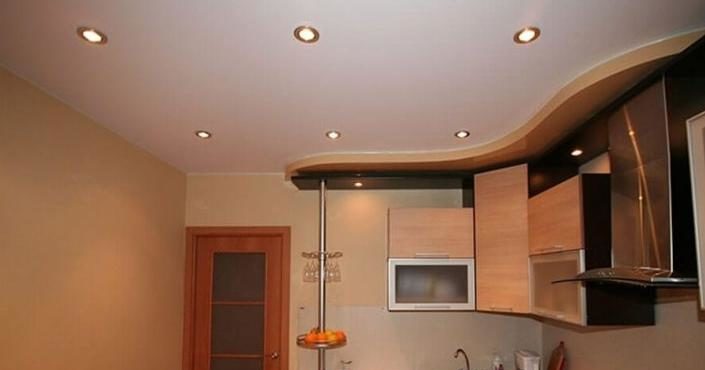
For information! Retractable adjustable options will work well, with their help it is easy to illuminate exactly the area that is needed.
Living room and hall
In these rooms, the location of lighting fixtures on the ceiling can be anything. It all depends on the size of the room, the arrangement of furniture and the nuances of the use of this or that zone. The features are as follows:
- Usually the central place is occupied by one or two chandeliers. Built-in elements are used as an additional source of light, which has both practical and decorative value.
- If the ceiling is made in the form of shapes or has niches and protrusions, the position of spotlights is selected according to their configuration. At the same time, it is necessary to keep in mind the distance that should be respected.
- It is possible to allocate a separate zone, if it is used for games or needlework. In this case, it is better to let a separate switch button on a group of lights.
- For decorative use, highlighting some elements or illuminating pictures, you can put the equipment close to the wall or even put it in niches.
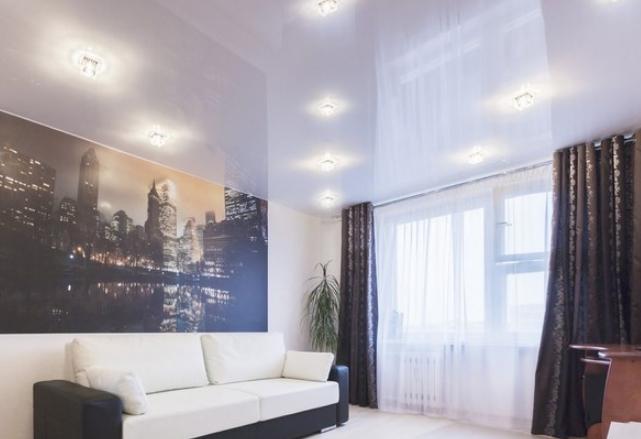
Any kind of project is possible here, especially if the area is large. But you have to remember that the more fixtures in the ceiling, the more complicated the wiring scheme and higher installation costs.
Bedroom
In this room most often rest, so it is better to use quiet muted light, which is evenly distributed throughout the area. But there are some peculiarities:
- You can illuminate the reading area by using recessed lights instead of traditional sconces.
- The space near the closet should be highlighted. This is where a person gets dressed and evaluates the appearance.
- If the bedroom has a dressing table or a desk, this area should be illuminated separately to turn on a bright light if necessary.
In this room, you can embed light fixtures in both the stretch ceiling and in the closet, if it is of large size. If the area of the room is small, it is realistic to do without a chandelier.
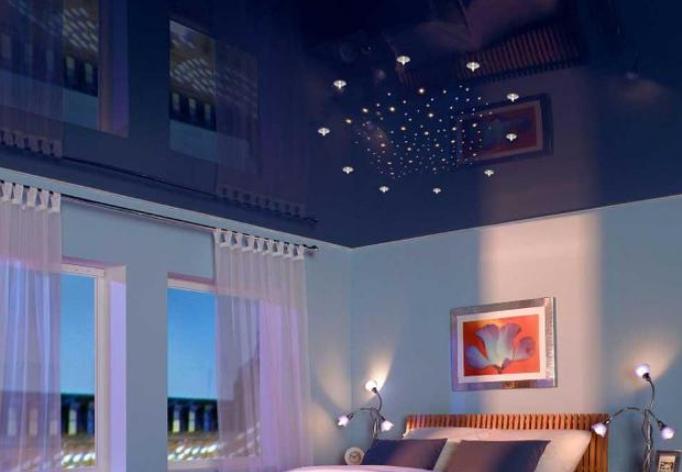
Children's room
In this room, focus on the quality of lighting. It should be close to natural daylight, so that the child does not strain his eyesight. The rules are as follows:
- Place spotlights as an additional element. It is best to use LED models.
- Highlight the play area and the desktop so that there is perfect lighting.
- You can install strip lighting around the perimeter, so that at night there is a dimmed light to replace a nightlight.
Use safe equipment. If possible, put lights with at least minimal adjustability to set the light well.
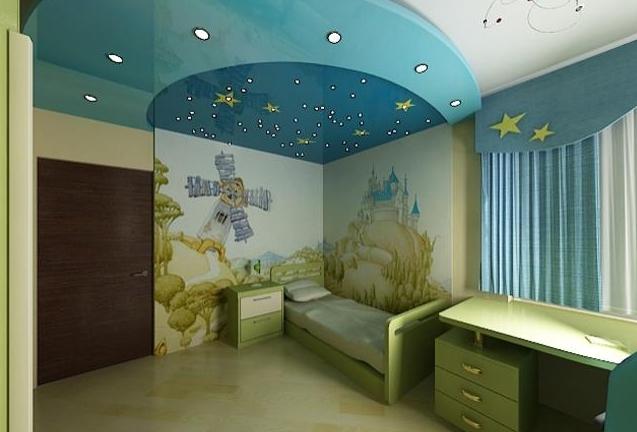
Thematic video
Bathroom and bathroom
Most often these rooms are small, so they can be fully illuminated with built-in lights. The basic rules are as follows:
- If the bathroom is tiny, it is enough to put two elements in the middle to evenly illuminate the space.
- For the bathroom, select the location of light sources so that the space in front of the mirror is well illuminated.
- Use only moisture-resistant models.
- Choose the scheme according to the area and shape of the room. Most often the lights are placed along the walls, but you can add a few in the middle.
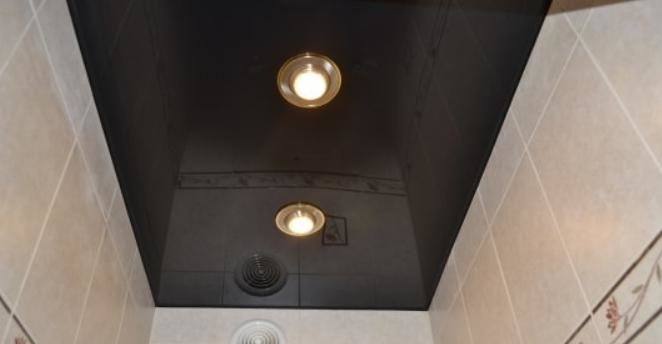
Choose the right location of spotlights in a suspended ceiling is not difficult, if you use the recommendations from the review and take into account the peculiarities of the room. It is worth observing regulations on the distance and taking into account the presence of other lighting equipment.
